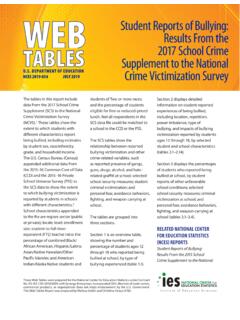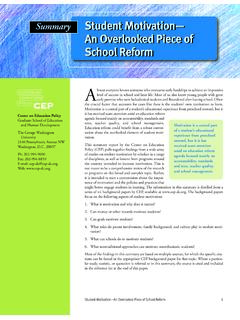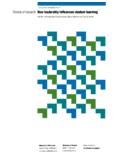Transcription of STRENGTHENING FAMILIES SELF-ASSESSMENT TOOL FOR …
1 ABOUT THE SELF-ASSESSMENT The Program SELF-ASSESSMENT helps programs determine how well they are implementing strategies to strengthen FAMILIES . The SELF-ASSESSMENT is based on findings from a national study that identified exemplary programs across the country. It allows all programs to compare their practices with those of the exemplary programs and identify areas for improvement. The SELF-ASSESSMENT outlines how the protective factors can be supported through small but significant changes in program practice. It is written for programs committed to working with and supporting the FAMILIES they serve. Versions of the SELF-ASSESSMENT are available for: center -based early care and education programs Family child care settings Home visiting programs Community-based programs such as family resource centersWhile there is significant overlap across these different versions, each also contains unique strategies specific to each setting.
2 The Program SELF-ASSESSMENT materials in this document are applicable to early childhood programs of any size, budget or structure. The strategies described can be implemented without creating new staff positions, making significant changes to existing facilities or raising additional financial SELF-ASSESSMENT outlines practices used by exemplary programs to support FAMILIES , organized around five protective factors: Parental Resilience Social Connections Knowledge of Parenting and Child Development Concrete Support in Times of Need Social and Emotional Competence of ChildrenEach section starts with a brief description of the protective factor and core strategies for building that protective factor. SELF-ASSESSMENT items are organized under each of these core strategies. In this version of the SELF-ASSESSMENT there are two additional sections that address STRENGTHENING FAMILIES in Special Circumstances: Responding to Possible Child Abuse or Neglect and Supporting a Child s Transitions to school or Other version of the SELF-ASSESSMENT for center -based early care and education programs has been tiered to facilitate use by states Quality Ratings and Improvement Systems.
3 Items are divided into four tiers that represent different levels of depth of implementation: Baseline ( , items that any early childhood program should be able to implement), Mid-level ( , items that require more specific attention to parent engagement) and High ( , items that reflect a high level of focus on parent engagement and support). The fourth tier, Comprehensive Service Programs, applies to those centers that offer a comprehensive range of supports and services to children and FAMILIES in addition to high quality early care and education ( , Head Start, family support centers).COMPLETING THE SELF-ASSESSMENTW hile the SELF-ASSESSMENT forms may appear long at first glance, most sections have fewer than fifteen items. To make the process easier, the forms address specific practices; thus, multiple practice examples often appear under a single strategy.
4 While the time it takes to complete the SELF-ASSESSMENT will vary from program to program and from form to form, on average, each form can be completed in approximately 90 strongly recommends that programs create a SELF-ASSESSMENT team that represents a number of different perspectives at your program, including: Administrative staff and/or program director Early care and education teachers Family support staff (if applicable) Parents whose children participate in the programIncluding a diverse group of participants in the SELF-ASSESSMENT evaluation process allows programs to benefit from a large variety of viewpoints and perspectives. Once a team has been identified, the process begins by following the steps outlined , each member of the team should fill out the SELF-ASSESSMENT forms individually. Next, the team should convene to share and compare assessments.
5 Teams should use this time to discuss rating STRENGTHENING FAMILIES SELF-ASSESSMENT TOOL FOR center -BASED EARLY CARE AND EDUCATION PROGRAMS that differ among various team members, giving each person an opportunity to describe why they rated the practice the way they did and if appropriate to provide an example. Once everyone has had a chance to speak, all team members should be given an opportunity to re-rate the practice. It is not necessary for the entire team to come to consensus on every practice, but it is important that all team members come to understand each other s perspectives and that a final decision is made on how to rate the item based on broad consensus version of the SELF-ASSESSMENT can be entered online at Completing the SELF-ASSESSMENT online allows the program to print reports showing strengths and areas to focus on improvement, as well as to link to parent and staff AN ACTION PLANOnce all team members have re-rated the practices, the team should identify areas where the program scored highly.
6 Next, the team should create a sustainability plan to keep these areas strong. In developing a sustainability plan for each successful area, teams should be sure to specify: Key reasons for success in the area What needs to be done to ensure continued strength in the area Who will be responsible for maintaining successful outcomes in the areaNext, the team should highlight practice areas that a majority of the team rated poorly. While we encourage programs to work on each of these areas eventually, the team can begin by deciding whether each poorly rated practice should be addressed (1) immediately, (2) over time, or (3) not at all. Again, teams should allow time for discussion and reevaluation if/when team members disagree on practice ratings. When a majority of team members identify items that should be addressed immediately, teams should brainstorm plans to improve associated area outcomes.
7 Teams should be sure to specify: The expected results All required resources (including staff hour costs) A timeline for achieving the desired results Who is responsible for each action step Check-in points for monitoring implementation progress How and when longer term action steps will be addressed/implemented STRENGTHENING FAMILIES SELF-ASSESSMENT TOOL FOR center -BASED EARLY CARE AND EDUCATION PROGRAMS STRENGTHENING FAMILIES SELF-ASSESSMENT TOOL FOR center -BASED EARLY CARE AND EDUCATION PROGRAMS RESILIENCEB eing a parent can be a very rewarding and joyful experience. But being a parent can also come with its share of stress. Parental resilience is the process of calling forth one s inner strength to proactively manage stress, meet personal/family challenges and be able to function well. Parental resilience includes the ability to provide nurturing and supportive care to one s child, even when faced with challenges, adversity or trauma.
8 Programs can provide a variety of resources for FAMILIES to help build and support parental resilience all with low or no-cost to the program. For example, programs can: Demonstrate in multiple ways that parents are valued Honor each family s race, ethnicity, language, culture, history and approach to parenting Encourage parents to manage stress effectively Support parents as decision-makers and help build parents decision-making and leadership skills Help parents understand how to buffer their child during stressful timesWhen supported by program policies, staff can employ these concrete Everyday Actions to help FAMILIES reduce personal/parental stress and gain confidence in their ability to overcome challenges. Staff strive to recognize and affirm the central role of parents in their children s lives through every interaction with FAMILIES including policies, practices and informal 1No RESILIENCE: SELF-ASSESSMENT ITEMSHow do programs demonstrate that parents are valued?
9 5: Strongly agree4: Agree3: Neither agree nor disagree2: Disagree1: Strongly disagree Not ApplicableComments STRENGTHENING FAMILIES SELF-ASSESSMENT TOOL FOR center -BASED EARLY CARE AND EDUCATION PROGRAMS The program has multiple avenues for regular communica-tion with 1No The program provides an orien-tation for FAMILIES about the program philosophy, educational goals and curriculum Staff regularly ask parents about their observations of their child to inform Staff use a variety of methods ( , new family orientations, small group meetings, individual con-versations, written questionnaires) to regularly provide information to FAMILIES and to gather family input on curriculum Staff regularly and frequently share information on children s progress with 4No All family members are made to feel Someone is available to greet FAMILIES when they come Staff are respectful even when family visits are Images and artwork throughout the physical space reflect the racial and ethnic diversity of parents and FAMILIES in the program Parents are welcome to visit at any Activities are offered to address the specific interests and needs of fathers, mothers and other family 4No RESILIENCE: SELF-ASSESSMENT ITEMSHow do programs demonstrate that parents are valued?
10 5: Strongly agree4: Agree3: Neither agree nor disagree2: Disagree1: Strongly disagree Not : Strongly agree4: Agree3: Neither agree nor disagree2: Disagree1: Strongly disagree Not Applicable STRENGTHENING FAMILIES SELF-ASSESSMENT TOOL FOR center -BASED EARLY CARE AND EDUCATION PROGRAMS Staff develop mutually respectful relationships with all family members by:Tier Regularly inquiring about what is happening in their Providing emotional support and Using intake forms, applications and surveys that are Sharing appropriate informa-tion about Taking time to get to know fam-ily members individually, by Recognizing and acknowledg-ing parents strengths, efforts and Taking time to understand the complex needs of individual family members, such as navigating child custody or the child support system, playing dual roles in a single-parent household or having children with different partners.








